Sound & Vision got creative at Culture Jam 2015

At the Europeana Creative ‘Culture Jam’ event, the closing conference of the widely praised Europeana Creative project at the National Library of Austria (ONB) on July 9th and 10th, the Netherlands Institute for Sound & Vision was well represented with pilot pitches, poster presentations and demo sessions. As a core partner in the Europeana Creative project and related Europeana Space project, there was plenty to discuss and bring to the attention of the creative industry scene in Vienna.
The Europeana Creative Culture Jam was a two day event that attracted over 190 participants from the cultural and creative industry domain from across Europe beyond. The conference was the final showcase event of Europeana Creative, a groundbreaking project that explores ways for creative industries to connect with cultural heritage. The programme was packed with inspiring keynote talks, workshops and lively discussions ranging from copyright to co-creation and from living labs to business models.
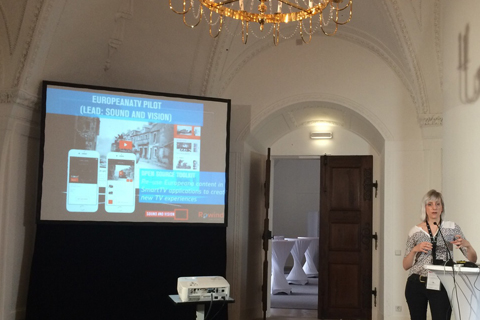
EuropeanaTV at Culture Jam 2015
The EuropeanaTV pilot was promoted by Kelly Mostert during ‘Poster Madness!’ and through a poster stand in the beautiful ONB reception hall. The poster attracted the attention of several creative entrepreneurs and creative thinkers. Furthermore, during a demonstration session the EuropeanaTV pilot and several apps were demonstrated and explained by Kelly Mostert in the workshop space.
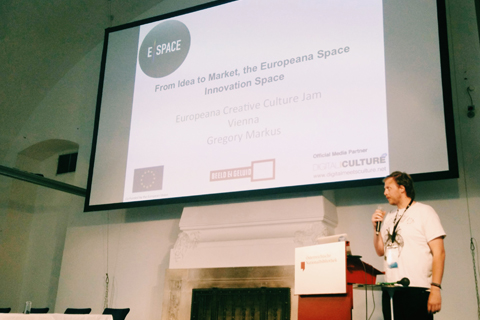
Europeana Space as sister project to Europeana Creative
Gregory Markus from Sound & Vision held a talk in the main conference room on the closing day of the conference to talk about Space, its relation to the Europeana Creative project, and how the project intends to tackle incubation of the creative concepts that come out of it. The talk was well received and Europeana Space definitely gained more spotlight as the Europeana Creative project comes to a close and Space remains to continue the efforts of finding new ways for sustainable and marketable creative re-use of digitized cultural heritage material.
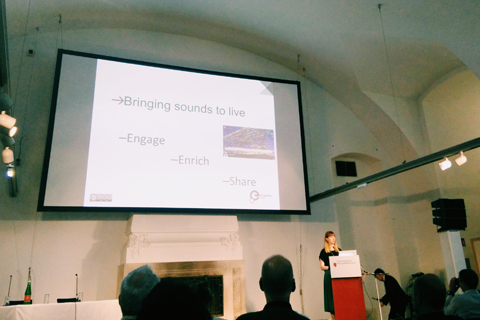
Europeana Creative Pilots
Lizzy Komen from Sound & Vision is responsible for overlooking the development of the five thematic pilots that came out of the project. The pilots demonstrate the possibilities of creative re-use of cultural heritage resources by creative industries. On the first day of the conference all pilots had the opportunity to pitch their ideas, concepts and applications to the audience, after which feedback was collected from the audience. The Design pilot Culture Cam, developed by the team of Aalto, AIT and Spild af Tid, was the winner in the category “gathered the most feedback” and won a 3D printed sculpture. Culture Cam allows you to visually browse a subcollection of Europeana’s content with in an easy and intuitive way through colour, shape or pattern. VanGoYourself attracted attention with their crowdfunding campaign to support their web based application that allows people to interact with cultural heritage by re-enacting a painting. People got creative during the conference and many recreations were done, including some original recreations by speakers. The other Pilots that were presented include the two educational based games Secret Legacy and Memory Match, Historiana, a history education tool for teachers and finally Sound Connections.
Sound Connections
Sound Connections, the Social Networks Pilot, was presented by Lizzy Komen. The pilot allows communities of interest to engage and enrich with archival sound collections on the themes of Amsterdam, London, bird and aviation sounds. Read more about this pilot on this recently published blog here.
LinkedTV and Cultuurlink
Two additional projects, in which Sound & Vision is proudly involved, were presented to the audience. LinkedTV, a project that aims to interlink Web and TV seamlessly, was presented by Lyndon Nixon from MODUL University. And Cultuurlink, a tool that allows you to align your vocabulary with the Dutch cultural heritage hub, was presented by Michiel Hildebrand from Spinque. Participants were able to learn more about these interesting projects and test the applications themselves at the exhibition space.
Highlights of the Culture Jam
The project promotional activities were accompanied by a very well structured conference and incredibly inspiring speakers, amongst which these were the highlights:
Michael Edson: “Work with the areas of the Internet that are less familiar to you, but very familiar to your visitors.”
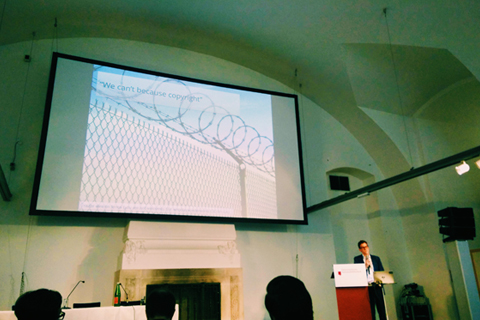
Joris Pekel: “Opening up your collections gives you more control over content, not less!”
- Focus on curated, relevant datasets to counter the “but we’re not ready for it” claim, as institutions often have huge datasets without proper metadata.
- Find the path of least resistance in terms of copyrighted content that you have to counter the “we can’t, we don’t have the rights on this” complaint - for instance seeking out content of rights holders that are close in your network and easy to persuade.
- There is no business model in locking up images, only in opening them up as an argument to counter the “but we won’t make money, people will steal our stuff” claim. There is always the example of the Rijksmuseum, where the two sales staff members are now spending their time doing much more lucrative things such as grant writing.
- Opening up gives you more control over content, not less as a rebuttal to people who think putting their stuff online will not harness any results for the institution. People are often inclined to click the link of a well known institution, and overall having more content out there will increase online traffic to the official website and offline traffic to museums.
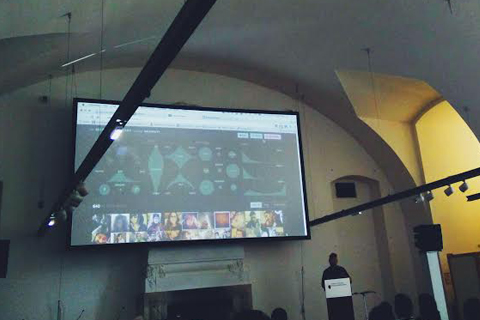
Lev Manovich: “Get you API’s ready, we are waiting.”
- Selfiecity: Interactive web app for exploring a dataset of 3200 Instagram selfie photos
- TimeLine: Covers of Time magazine from 1923 until 2009, showing for instance that covers from the 1960s onwards showed a lot more saturation and color
- On Broadway: The interactive installation and web application "On Broadway" represents life in the 21st-century city through a compilation of images and data collected along the 13 miles of Broadway that span Manhattan.
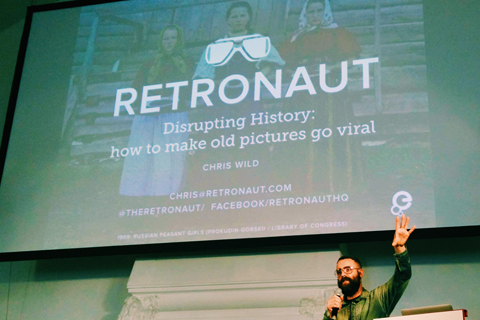
Chris Wild: “When we care, we share.”
- [S] - Seeable; You have to be able to see the picture. You might have lots of stories and information to tell, but make sure the picture takes front stage.
- [P] - Positive; This picture should have a benefit to the viewer. Why is it a gift to them? Why is it unique?
- [E] - Easy; The situation depicted in the picture should not be too complicated.
- [E] - Emotive; When we care, we share. Look for an emotive quality.
- [D] - Disruptive; Highlight pictures that do not fit with the usual images of this location or era. One example is this nose job picture from the Wellcome Library.
Image credits
- All images CC-BY Kelly Mostert
